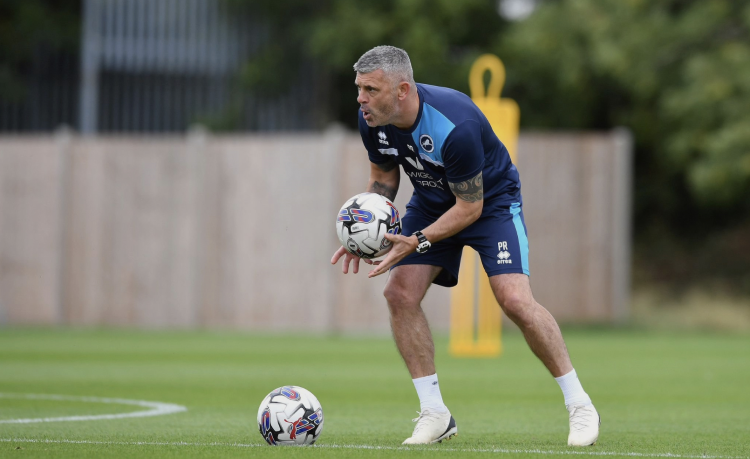This session covers crossing areas in the final third of the pitch, and isolates the key need for attackers – to instantly know which areas should be attacked and where the best goalscoring opportunities are.
| Area | Up to a half-pitch |
| Equipment | Balls, cones, goals, mannequins |
| No. of Players | Up to 18 |
| Session Time |
Each step: 10mins, Tramline game: 20mins |
This session covers crossing areas in the final third of the pitch, and isolates the key need for attackers – to instantly know which areas should be attacked and where the best goalscoring opportunities are.
For attackers, the final third is the end product. If your team can increase its options when it comes to scoring goals, it has a much greater chance of winning matches.
The true benefit of practising this session is in crossers not having to look up before they cross, because through practice, they know their attackers will automatically make a beeline for key areas.
While this is an attack-minded practice, it also benefits defenders, who can learn where good attackers will run to, and how best to stop the subsequent cross.
What do I get the players to do?
Final third practice
This practice uses up to 18 players, including two keepers. We agree three realistic areas from where goals are scored:
Step one: Early cross
Step two: Cross from outside the box
Step three: Cross from inside the box
Step one (1)
The move starts from 30 yards out, with the ball going left or right to a midfielder. He feeds the wide man, who can have two touches but must cross early. Forwards move off their mannequins, timing their runs so to stay onside and attack the ‘second six-yard box’, which is the intended delivery area for the ball.
We use multiple players on each station so momentum is maintained after each attack finishes.
1
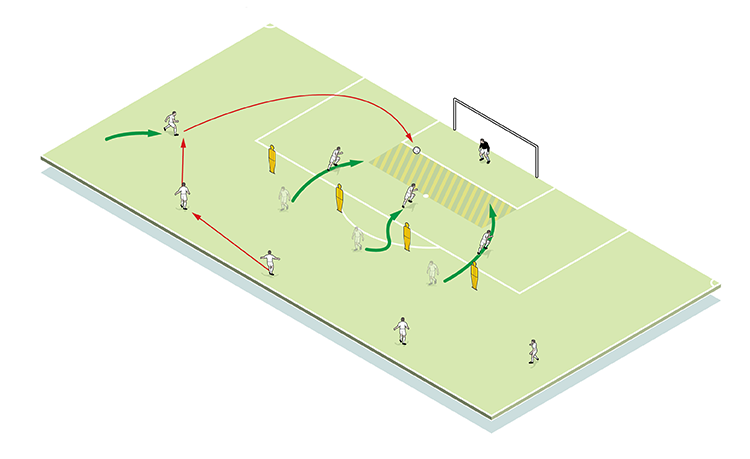
Step two (2)
The next step uses only one main striker, as shown, and features midfielders running from deep. The wide man is overlapped to create a 2v1 overload option, and the subsequent cross must not hit the first defender (mannequin), to the side of the six-yard box. Players not involved at the start are the deep runners, and attack the ball in the ‘second six-yard box’.
2
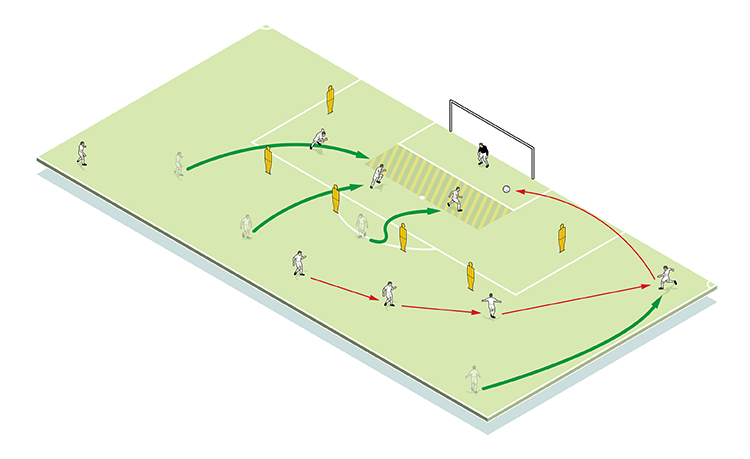
Step three (3)
For step three, the wide man crosses or passes inside the box. The receiver takes the ball and turns inside to pass into the box for his overlapping player. The subsequent cross or pass must not be low, because this slower set-up means more defenders will have regrouped and are likely to block a low grounded pass.
3
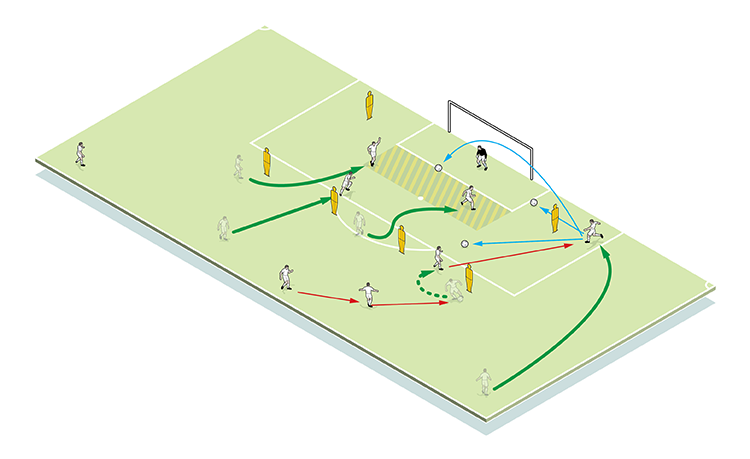
What are the key things to look out for?
Communication helps timing and realism, and it’s important for the coach to agree with players where space will be, and where defenders will realistically head to. Players need to use imagination, make realistic runs, show good timing and must stay onside.
Tramline game (4/5)
On a half-pitch, this is a 9v9 including keepers. Play as you would do a normal game, though only one defender is allowed in the tramline area. There is no restriction on attackers inside the tramline, but we might limit touches. Goals can only be scored from crosses, or rebounds from crosses.
4
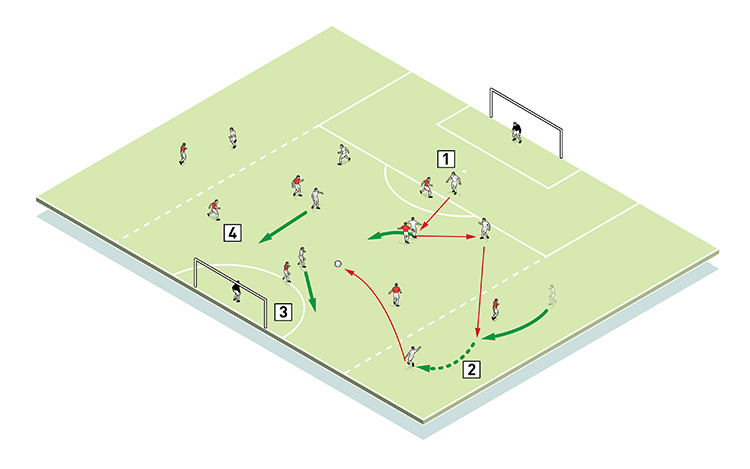
2. The ball is fed wide into the tramline
3. One attacker moves into the space and an early cross is delivered
4. Midfielders and the lone attacker replicate their movement in the practice to take up positions in front of goal
5
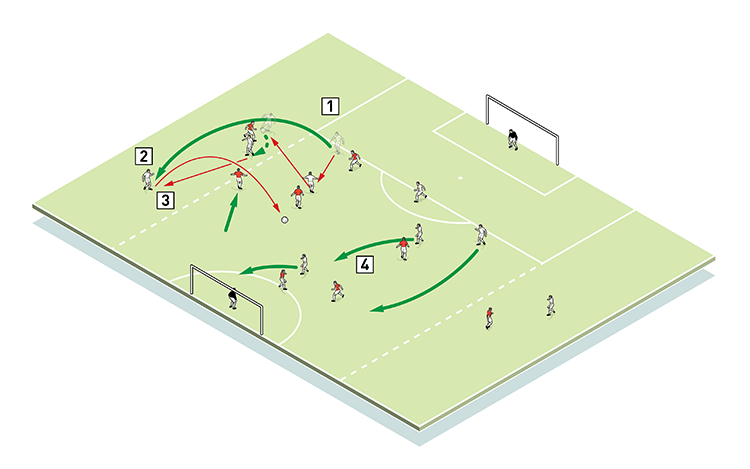
2. After making a pass in-field, the full- back overlaps the wide player
3. The wide player beats his man and feeds the overlapping full back who crosses
4. Midfielders prepare to break forward
Related Files
Editor's Picks
Attacking transitions
Deep runs in the final third
Using the goalkeeper in build-up play
Intensive boxes drill with goals
Penetrating the final third
Creating and finishing
My philosophy
Pressing initiation
Compact team movement
Coaches' Testimonials
Related
Crossing, finishing and defending
Third phase overload and finishing pattern
Passing and running in behind
Unlocking the wing backs
Coaches' Testimonials
Join the world's leading coaches and managers and discover for yourself one of the best kept secrets in coaching. No other training tool on the planet is written or read by the calibre of names you’ll find in Elite Soccer.
In a recent survey 92% of subscribers said Elite Soccer makes them more confident, 89% said it makes them a more effective coach and 91% said it makes them more inspired.
Get Monthly Inspiration
All the latest techniques and approaches
Since 2010 Elite Soccer has given subscribers exclusive insight into the training ground practices of the world’s best coaches. Published in partnership with the League Managers Association we have unparalleled access to the leading lights in the English leagues, as well as a host of international managers.
Elite Soccer exclusively features sessions written by the coaches themselves. There are no observed sessions and no sessions “in the style of”, just first-hand advice delivered direct to you from the coach.















